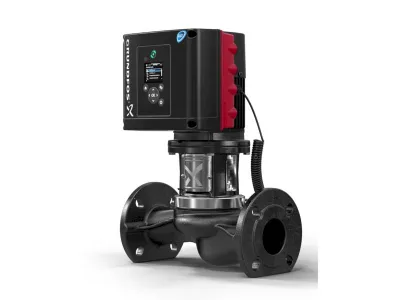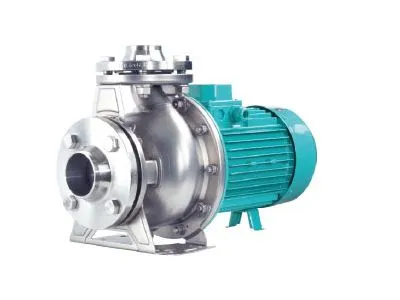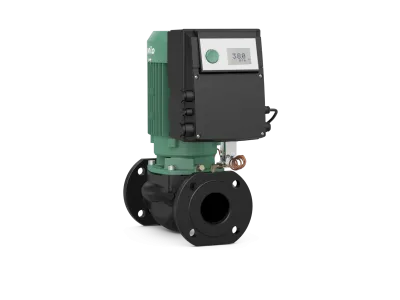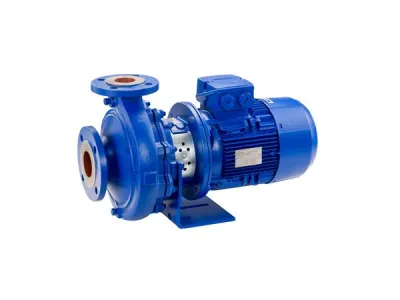E-pumps instead of bypass valves
Buildings with a greater need for refrigeration are often equipped with central cold water systems. The cold water draws heat from the rooms either directly (via fan convectors or by component activation) or indirectly via an air conditioning system in which cooled air is introduced into the rooms via a duct system. Smart pumps can significantly influence the necessary system technology and costs.
Whether caused by natural or anthropogenic causes: climate change is real. This is reflected in local weather phenomena (heavy rain, hurricanes) as well as in higher average temperatures. The immediate consequences: Higher temperatures require more cooling in a wide variety of areas (food, buildings, data centers, production facilities). In Germany, approx. 66 billion kWh of electricity and 11 billion kWh of non-electrical energy are used annually for technical refrigeration - this corresponds to 14 percent of our total electricity requirement. Of this, 22% is accounted for by the air conditioning of buildings (Source: BINE).
Improve the efficiency of the air conditioning
In the summer we consume significantly more electricity because of the air conditioners today than in winter. Manufacturers as well as planners and operators are therefore looking for ways to reduce the costs of air conditioning systems - this is achieved, among other things, through optimized efficiency.
To stay with the cold water systems: One of these are the pumps working here: They are the heart of every cold water system, although they account for only 5% of energy consumption. However, they have an indirect influence on how the other components for energy transmission in the building work. The performance of chillers, cooling towers, air conditioners or fan coils is directly dependent on the characteristics of the pumps working here.
For every design of a pump, the aim is that the operating point is in the range with the highest efficiency of the pump. Often, however, it is not possible to select a pump for the exact operating point because the system requirements are dynamic and the load pattern of the building changes. It is therefore necessary for the pump system to adjust its performance according to changes in the load pattern of the building. In addition to using throttle valves and turning the impeller, speed control with a frequency converter is the most efficient way to adjust the performance of a centrifugal pump.
Planning an optimal cold water system
Optimally controlled cooling systems are essential for a good indoor climate and low operating costs. Variable Volume Flow (VPF) systems are perfectly suited for achieving this goal. However, to prevent freezing and shutdown, a minimum volume flow must be ensured in chilled water systems and the equipment must have a fast discharge capacity. This discharge capacity can be achieved through a precise control system, variable capacity compressors, pumps, fans and an easily regulated bypass line.
Too much and too fast lowering of the flow increases the risk of icing. The solution is often chosen to install a bypass valve in the common line. The result is a system that requires a precise control system to ensure the optimal interplay of all plant components - which basically means efficiency at the expense of greater complexity!
The solution recommended by Grundfos: The replacement of the conventional bypass valve by a TPE3 pump makes it easier to maintain the chilled water system and ensures a constant minimum flow rate in the chiller. The pump is controlled in the control mode constant differential pressure (ΔP), whereby the evaporator of the chilled water system a constant pressure and thus a constant flow is kept independent of the plant load. Once the flow rate through the chiller system is above a safe minimum level, the TPE3 pump automatically shuts itself off. This operation ensures that the performance of the primary variable speed pumps can be reduced independently of the limits set for the minimum flow rate of the refrigeration unit.
The Grundfos bypass pump solution ensures that the main pump's performance is completely independent of the minimum flow limits for the chiller. This avoids excess flow in the system and also minimizes operating costs. Since only one TPE3 pump and one differential pressure sensor are required for this solution, the system complexity is reduced:
- the right water temperature is guaranteed at all times
- The temperatures can be read out and documented via the mobile monitoring and configuration solution GrundfosGO
- simpler planning and specification, since the temperature is the only basis
- There are no throttle valves required
- the operating costs for the pumps fall.
Inline pump with smart algorithms
With TPE inline pumps, the pressure and suction ports are straight-lined, which simplifies pipe installation. The glanded pumps are made in block design and therefore far less sensitive to contamination in the pumped medium than wet-runner circulating pumps.
With intelligent controls and numerous other features, the TPE3 pump can play a central role in heating, air conditioning and heat recovery systems. Two functionalities are particularly interesting:
- AutoAdapt function: Unlike a conventional electronic control, the pump regularly checks the system conditions and adapts the proportional pressure curve automatically. Even if the system conditions are not known exactly (for example, when replacing an existing pump), the AutoAdapt function adjusts the setpoint of the pump automatically.
- FlowAdapt function: This is a combined feature of AutoAdapt and FlowLimit. FlowLimit can be used to set a maximum value for the flow rate. The pump continuously monitors the flow rate and prevents it from exceeding the maximum value.
Such 'E' pumps with the IE5 maximum efficiency motor do not simply promote medium from A to B; Rather, they are system solutions that solve demanding and complex conveying tasks with minimal energy consumption.
Equipped with analog and digital inputs and outputs as well as other interfaces, the operator can use a large number of integrated pump functions for the respective application with the IE5 drive. The range extends from simple process control with constant parameters (pressure / volumetric flow / filling height / temperature) to complex controls that adjust to the individual conditions of a system itself. There are also monitoring and process functions. In addition, hardware and software can be adapted to specific customer requirements ('Customizing').
Conclusion:
Highly efficient and integrated pump solutions for the HVAC trades do not only ensure cost-effective operation. Combined with state-of-the-art fieldbus solutions, they ensure transparency with regard to operating data and thus offer the option of preventive maintenance, which significantly improves operational reliability. The long-term effect of an IE5 motor should not be forgotten either: If you look only at the amortization of 3, 5 or 7 years, you probably ignore that efficient technology saves costs over the entire life cycle year after year.
* Wolfgang Richter, Director Project Business Facility Engineering DA, Grundfos GmbH, Erkrath.







